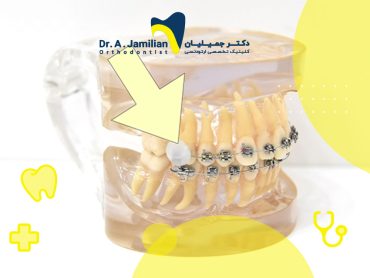Patients suffering from crooked and malpositioned teeth commonly decide to undergo orthodontic treatments to beautify their teeth and smile. There may be interactions between dental veneers and orthodontic appliances in such patients; an issue that this article will provide and address.
Most people wrongly perceive and interpret that orthodontic treatments are merely for aesthetic purposes. Did you know the effects of malpositioned or crooked teeth on your physical health? Any experienced orthodontist should brief the patient on all reasons for undergoing orthodontic treatments in counseling sessions. Data show that people with malpositioned teeth suffer from a variety of gastrointestinal disorders due to the difficulties in chewing foods. Therefore, large pieces of food entering their stomach increases the secretion of gastric acid and thereby many gastrointestinal disorders.

In some scenarios, the orthodontist may decide to veneer some of the teeth to correct any dental deformity or fracture, cover the repaired or denervated teeth, or strengthen dental bone tissue. Dental veneers are among the dentistry equipment used for both therapeutic and aesthetic purposes.
Orthodontic treatment of crowned teeth
There are times when the patient may need to undergo orthodontic treatments after veneering a section of your teeth. Likewise, the orthodontist may prescribe you to veneer some of your teeth during orthodontic treatment. For example, the orthodontist may decide to veneer some of your weak teeth to protect them against the pressure applied by orthodontic appliances or you may have a decayed tooth that needs restoration and then veneering. In these cases, orthodontic treatments and dental veneering would be done simultaneously.
Orthodontic treatments on dental crowns
According to the above discussions, the question arising here is whether those with dental crowns can undergo orthodontic treatments. The answer is “Yes”; such patients and individuals can certainly take advantage of orthodontics. Any experienced orthodontist will initially take images of teeth and jaws to get enough information to choose the best orthodontic method and where the brackets should be placed. For example, such images help the orthodontist to better decide about veneered teeth. On the one hand, veneered teeth should be also aligned and, on the other hand, it is slightly difficult to attach brackets to veneered teeth. Therefore, the orthodontist should apply special orthodontic techniques for veneered teeth. Below, the most important techniques used by experienced orthodontists to deal with the interaction between orthodontics and dental veneers are explained:
- In some cases, the orthodontist may use orthodontic elastics to align veneered teeth without damaging them.
- In cases where there exist some adjacent veneered teeth, the orthodontist reviews dental radiographs and then may decide to trim the veneer of adjacent teeth to more easily attach the brackets. In such cases, the veneers must be replaced later.
- Orthodontists use hydrofluoric acid (HF acid) instead of phosphoric acid for acid-etching the buccal surface of dental veneers.
Finally, patients who have never veneered their teeth and now want to undergo orthodontics are usually recommended to first do orthodontic treatments and then veneer their teeth to avoid the interaction between orthodontics and dental veneering. Moreover, in cases where tooth extraction is necessary, the teeth that need to be veneered are more preferred for this purpose.







